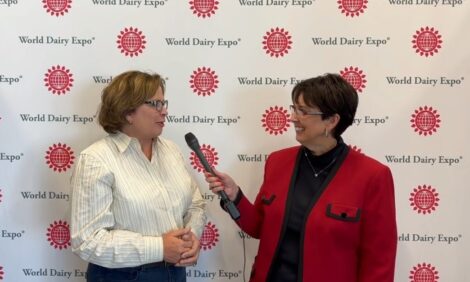



Weekly global protein digest - Weekly USDA dairy report including international market highlights
Livestock analyst Jim Wyckoff reports on the global protein newsWeekly USDA US beef, pork export sales
Beef: Net US sales of 10,000 MT for 2024 were down 43 percent from the previous week and 27 percent from the prior 4-week average. Increases were primarily for South Korea (3,900 MT, including decreases of 200 MT), Japan (1,900 MT, including decreases of 400 MT), Mexico (1,200 MT, including decreases of 100 MT), China (700 MT, including decreases of 100 MT), and Canada (600 MT, including decreases of 100 MT). Exports of 15,400 MT were down 5 percent from the previous week and 2 percent from the prior 4-week average. The destinations were primarily to Japan (4,000 MT), South Korea (3,400 MT), China (2,700 MT), Mexico (1,600 MT), and Taiwan (1,200 MT).
Pork: Net US sales of 34,600 MT for 2024 were up 10 percent from the previous week and 24 percent from the prior 4-week average. Increases were primarily for Mexico (14,800 MT, including decreases of 400 MT), China (7,400 MT), Japan (2,900 MT, including decreases of 400 MT), Colombia (2,500 MT, including decreases of 100 MT), and Canada (1,700 MT, including decreases of 600 MT). Total net sales of 200 MT for 2025 were for New Zealand. Exports of 33,200 MT were up 10 percent from the previous week and 4 percent from the prior 4-week average. The destinations were primarily to Mexico (14,400 MT), Japan (4,700 MT), China (3,100 MT), South Korea (2,700 MT), and Colombia (2,500 MT).
China’s July meat imports drop sharply from year-ago
China imported 540,000 MT of meat during July, up 25,000 MT (4.9%) from June but down 125,000 MT (18.8%) from last year. Through the first seven months of 2024, China imported 3.835 MMT of meat, down 14.5% from the same period last year.
China bans poultry imports from RGDS in Brazil
China’s customs authority banned imports of poultry and related products from Brazil’s Rio Grande do Sul due to an outbreak of Newcastle disease.
China halts imports of meat and meat products from Swift Beef plant
The plant is in Grand Island, Nebraska--Lineage Logistics cold storage facilities in Grand Island, Nebraska, and Windsor, Colorado, effective July 30. This marks the second Swift Beef facility banned by China, following a May 27 suspension of imports from the Swift plant in Greeley, Colorado.
No reason was given for the suspension, but some reports signal the primary reason for these suspensions may have been the detection of ractopamine, a feed additive used to promote leanness and increase weight in livestock. Ractopamine is banned in over 160 countries, including China and the European Union, due to concerns over animal welfare and potential human health risks. In the case of the Greeley, Colorado, plant, U.S. officials reportedly found traces of ractopamine in meat destined for export to China, leading to the suspension.
Weekly USDA dairy report
CME GROUP CASH MARKETS (8/2) BUTTER: Grade AA closed at $3.1050. The weekly average for Grade AA is $3.1100 (+0.0255). CHEESE: Barrels closed at $1.9300 and 40# blocks at $1.8500. The weekly average for barrels is $1.9635 (+0.0035) and blocks $1.9125 (-0.0085). NONFAT DRY MILK: Grade A closed at $1.2400. The weekly average for Grade A is $1.2425 (+0.0195). DRY WHEY: Extra grade dry whey closed at $0.6100. The weekly average for dry whey is $0.6090 (+0.0680).
BUTTER HIGHLIGHTS: In the West, domestic butter demand varies from somewhat stronger to slightly weaker for both the retail and food service sectors. For the Central and East regions, domestic butter demand is steady from the retail sector, while demand from the food sector is lighter. Cream is tightening throughout the country. Butter manufacturers indicate mixed demand for cream. Stakeholders convey some Central region butter churns are utilizing cream sourced from the West. Butter production schedules are mixed. Some manufacturers indicate bulk production lines are especially light, but also within anticipated seasonal trends and comfortable. Bulk butter overages range from minus 3 to 10 cents above market, across all regions.
CHEESE HIGHLIGHTS: Cheese production schedules are trending steady to lighter throughout the U.S. Contacts in the East relay lighter cheese production schedules due to tightening milk availability. Retail and foodservice demands are steady. Cheesemakers in the Central region are running active production schedules. Cheese inventories are tighter in the Central region. Spot milk prices ranged from flat to $2-over Class III. Cheese manufacturing is seasonally weaker in the West. Spot milk availability is overall tighter in the region. Spot cheese loads are available for spot buyers, but contacts share some contractual commitments are behind lead times. The NASS Cold Storage report for June showed total natural cheese stocks were down 1 percent from May and down 6 percent from June 2023.
FLUID MILK: Milk volumes are seasonally trending lower across most regions of the United States. Over most of the country, high temperatures and humidity are pressing milk volumes lower. Lower volumes stretch from the Northeast and down the Atlantic Coast. Some larger farms in Florida are seeing more steady volumes, while other parts of the state are seeing steep declines. Most of the West is dealing with lighter milk production with the Pacific Northwest conveying a slight increase. Demand for all Classes in the West has not changed and is steadily soaking up any multiples available. The Midwest is not immune to the doldrums of summer. Farm level milk continues to decline as the summer temperatures climb. Spot milk in the Midwest is scarce and becoming more difficult to find. Class I demand is ticking up as regions prepare for school to start in the coming weeks. The same can be said for cream and condensed skim milk. All regions of the country are experiencing strong demand and tight availability for cream and condensed skim milk. Some requests for condensed skim milk in the West could not be filled for lack of available stock. Class IV demand for cream is strong with butter makers as they keep busy production schedules. Class II and III demands are steady. Cream multiples for all Classes are 1.30 - 1.50 in the East, 1.22 - 1.39 in the Midwest, and 1.18 - 1.37 in the West.
DRY PRODUCTS: Low/medium nonfat dry milk prices moved higher. Stakeholders indicate spot availability is much tighter in the southwest portion of the country. High heat nonfat dry milk prices also moved higher. Stakeholders note stocks are on the tight end. Dry buttermilk prices on the Central/East and West regions’ price ranges were mostly unchanged this week. Domestic demand is indicated as weak outside of contracted loads. Dry whole milk had slight upward price movement. Inventories continue to be tight. Dry whey prices climbed upward across all regions. Dry whey availability is tight. Whey protein concentrate (WPC) 34% prices are unchanged. Domestic demand for WPC 34% continues to be weak. Lactose prices were mostly steady. Lactose production is limited with seasonally lighter milk intakes. Acid and rennet casein prices held steady. Demands are mixed.
INTERNATIONAL DAIRY MARKET NEWS:
WEST EUROPE: Although EU milk output is generally above last year’s volume for the first five months of the year, weekly milk collections are seasonally decreasing. As milk volumes fade in the summer heat, cream has also become less available. Industry sources say cream prices have risen and so has demand for the fresh market products that use cream. As the summer holidays end, market participants expect a rise in demand for most dry dairy ingredients, butter, and cheese. The monthly weighted average price for EU 27 farmgate milk has stayed near 46 euros per 100 kg for much of the first half of the year, with most of the EU 27 countries having a pay price between 40 and 50 euros per 100 kg in the month of June. Current weekly milk spot prices in the upper 50 euros per 100 kg are common. While the higher milk pay prices and the lower feed costs have helped farmer finances improve, lower numbers of dairy cows on the continent and tight supplies of replacement heifers have slowed the potential growth of milk output in some regions of Europe.
EAST EUROPE: Milk production in East Europe continues to grow year over year, even as seasonal milk output slows. Decreases in feed costs, coupled with consistently supportive milk pay prices have help maintain farm financials, leading to expanded milk production. The May farm milk pay price in Poland was 46.34 euros/ 100 kg compared to 45.90 euros/100 kg across the EU 27.
AUSTRALIA: In Australia, farmgate milk prices for the 2024 - 2025 season were cut by around 15 percent from several processors, amid increasing competition from imported dairy products. A spokesperson for a dairy farming group within Australia stated input costs have increased in recent years and lower milk prices will add further pressure on dairy producers, which could drive more dairy farmers out of the market. A representative from a processor within the country noted lower priced butter and cheese imported into Australia is negatively impacting sales within Australia.
NEW ZEALAND: Milk production data from New Zealand for June 2024 was recently released. This data showed total June 2024 production was down 1.1 percent on a tonnage basis compared to a year earlier. Export data for June 2024 was recently released for New Zealand. This data showed a combined 10 percent decrease in value for milk powder, butter, and cheese exported in June 2024 compared to June 2023. A group in New Zealand, which forecasts dairy production, is forecasting the volume of milk solids produced in New Zealand in July to decline by 0.2 percent from 2023, but they anticipate the volume of milk solids produced in the country to increase compared to last year from August through October.
SOUTH AMERICA: Substantial seasonal increases in milk production are yet to be detected in South America. Contacts suggest favorable weather conditions for cow comfort will spark increases in milk production in the near term. According to the USDA Foreign Agriculture Service (FAS) Argentine Grain and Feed Update published last week, corn production in marketing year 2024/2025 is projected at 49 million tons, 2 million tons lower than USDA estimates due to smaller planted acreage. Corn exports remain nearly unchanged at 35.5 million tons. Another FAS report released in July detailed the adverse effects of inflation on the Argentine dairy industry. Total milk production for 2024 is expected to fall 7 percent from 11.7 million tons in 2023 to 10.8 million tons. Rising prices for dairy products have changed purchasing behavior, and domestic fluid milk consumption for 2024 is forecast to fall 7 percent from 2024. Inflation and currency devaluation have prompted traders in Argentina to question whether to preserve stocks or trade on an international scale due to the competitiveness of current domestic price points.
NATIONAL RETAIL REPORT: The week 31 retail ad survey contained 8 percent more conventional dairy ads, compared to the prior week, while the number of organic dairy ads grew by 262 percent. The most advertised conventional commodity this week was cheese, despite a 7 percent decline in total ads from last week. The most advertised organic commodity in week 31 was milk, for which ads increased by 800 percent.



